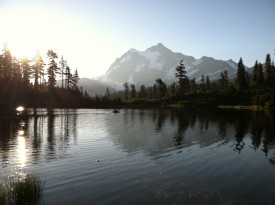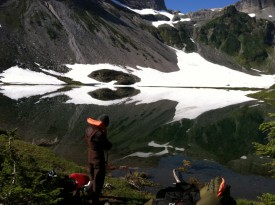by Siana Wong

Although seemingly pristine, high-elevation mountain lakes are quite sensitive ecosystems and can be vulnerable to anthropogenic and global changes.
As an M.S. student at Western Washington University, I had the great opportunity to conduct my graduate research in one of Washington’s most scenic areas — the high-elevation lake environment of the North Cascades. The way ecological systems function in these extreme settings is intriguing. With prolonged snow and ice cover, low nutrient supplies, and rapid seasonal transitions from snow and ice cover to intense sun exposure, high-elevation mountain lakes must be inhabited by organisms well-adapted to cope under these conditions. Due to the remote and extreme physical setting of these lakes, however, studying them can be logistically difficult. Consequently, much less is usually known about these systems relative to their low-elevation counterparts.
Although seemingly pristine, high-elevation mountain lakes are quite sensitive ecosystems and can be vulnerable to anthropogenic and global changes. In the North Cascades and other ranges of the Pacific Northwest, lake research and monitoring is largely focused on assessing the effects of atmospheric nitrogen deposition and the historic stocking of non-native fish. Additionally, substantial glacial retreat may alter the hydrology and ecological functioning of numerous lakes that dot the North Cascades landscape. We need greater knowledge of the current ranges and variations in the biological, physical, and chemical components of regional high-elevation systems to understand and predict how they may respond to changes over the long term.

High-elevation mountain lakes must be inhabited by organisms well-adapted to cope under extreme conditions.
Working with my advisor, Dr. Robin Matthews, and Karl Bruun of Nostoca Algae Laboratory, I focused my research on the ecology of phytoplankton in four proximal lakes near Mt. Baker. Because phytoplankton are prolific and diverse, these microscopic photosynthetic organisms are useful as freshwater bioindicators. Float-tubing out to the middle of each lake, I collected samples for water chemistry and phytoplankton analyses each week during the ice-free season from August–October 2012. Each sampling day ended with packs full of water samples and field equipment, followed by a long haul back to the Institute for Watershed Studies at Western Washington University, where water chemistry samples were processed and analyzed.
In summary, we identified over 80 unique phytoplankton taxa in the four lakes, with composition and abundances somewhat different than what would be encountered in more familiar low-elevation systems. Phytoplankton composition and abundance in the lakes could be related to water chemistry (e.g., temperature, nitrogen and phosphorus levels, pH), which is further influenced by the lakes’ external surroundings (e.g., snow and ice cover, forest and vegetation cover). Seasonal timing was also important to phytoplankton composition and abundance in these lakes. The seasonal succession of phytoplankton under extreme environmental conditions, squeezed into a small window of opportunity to grow and develop, may demonstrate the versatility of these organisms. This dataset will hopefully reveal additional interesting patterns. Further research into the ecology of North Cascade high-elevation lakes, spanning multiple spatial and temporal scales, is needed to more fully understand these systems.
High-elevation mountain lakes are cherished natural resources. They are relaxing places to fish; oases of solitude where one can sit quietly by still, reflective waters; prizes at the end of a grueling hike or climb; and refuges for native flora and fauna. It is often and truly said that knowing something well makes us appreciate it more; in this case, leading us to conserve and manage a dynamic, but often understudied, ecosystem.
Alpine Phytoplankton Gallery
[nggallery id=3 template=caption]










